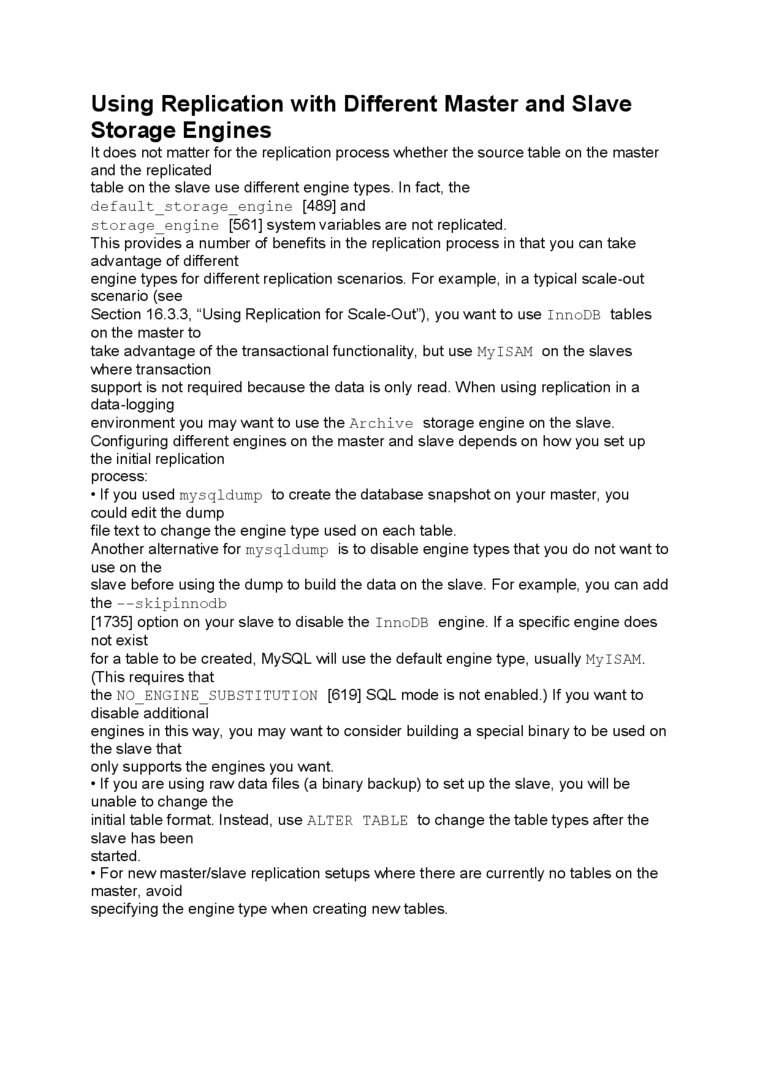89584

Using Replication with Different Master and Slave Storage Engines
It does not matter for the replication process whether the source table on the master and the replicated
table on the slave use different engine types. In fact, the default_storage_engine [489] and storage_engine [561] system variables are not replicated.
This provides a number of benefits in the replication process in that you can take advantage of different
engine types for different replication scenarios. For example, in a typical scale-out scenario (see
Section 16.3.3, “Using Replication for Scale-Out”), you want to use innoDB tables on the master to
take advantage of the transactional functionality, but use My ISAM on the slaves where transaction
support is not required because the data is only read. When using replication in a data-logging
environment you may want to use the Archive storage engine on the slave. Configuring different engines on the master and slave depends on how you set up the initial replication process:
• If you used mysąldump to create the database snapshot on your master, you could editthe dump
file text to change the engine type used on each table.
Another alternative for mysąldump is to disable engine types that you do not want to use on the
slave before using the dump to build the data on the slave. For example, you can add
the —skipinnodb
[1735] option on your slave to disable the InnoDB engine. If a specific engine does not exist
for a table to be created, MySQL will use the default engine type, usually MylSAM. (This requires that
the NO_ENGINE_SUBSTITUTION [619] SQL modę is not enabled.) If you want to disable additional
engines in this way, you may want to consider building a special binary to be used on the slave that
only supports the engines you want.
• If you are using raw data files (a binary backup) to set up the slave, you will be unable to change the
initial table format. Instead, use ALTER TABLE to change the table types after the
slave has been
started.
• For new master/slave replication setups where there are currently no tables on the master, avoid
specifying the engine type when creating new tables.
Wyszukiwarka
Podobne podstrony:
With lower infection rates and morę widespread testing, it is now feasible for the EU5 nations to us
Using different storage engines on master and slave. It is possible to replicate transactional table
Replication with Differing Table Definitions on Master and Slave Source and target tables for replic
Replication and Time Zones The same system time zonę should be set for both master and slave. Otherw
A field trial using DWS with dual gas lift well was performed in a depleted oil field in the Coastal
al creatures 15 Fairy hairstyles Be creative with your drawings and give your fairies some fun haird
00314 ?f49248905805fa4cf0d5be042fd4c1 317 Optimizing Defect Levels and Losses from Gage Errors Figu
m85 A Saxon housecarl and ceorl meet defeat at Hastings. (Bayeux Tapestry) for the local forces. Th
mb 09 MUSCLE BUILDING. 9 head and bctter body. It does not tako any apparatus —it
[21J Oh K. S., and T. S. Kim: Performance analysis on various system layouts for the combination of
hit and run Assassination! This is an Instant Attack to Destroy any Personality, at any time. It doe
Nancv Irwin in Bride 0 coordinate casting and to teach dic-tion. Makeup & movement Rehearsals fo
Create a mysqi User and Group lf your system does not already have a user and group for mysqid to ru
CCF20110611�030 M Sharing probiems: problem s ha ring can contr! butę to encouragement and progress
więcej podobnych podstron